Setting goals is a crucial part of professional development for any career. For teachers, establishing clear, achievable objectives enhances their teaching effectiveness and promotes personal growth and student success. The SMART criteria is one of the most effective ways to set these objectives. This article will explore the SMART principle example, provide professional SMART development goals for teachers, discuss how teachers can develop these goals, and address challenges in setting and achieving these goals.
What are the 5 SMART Principles Example?
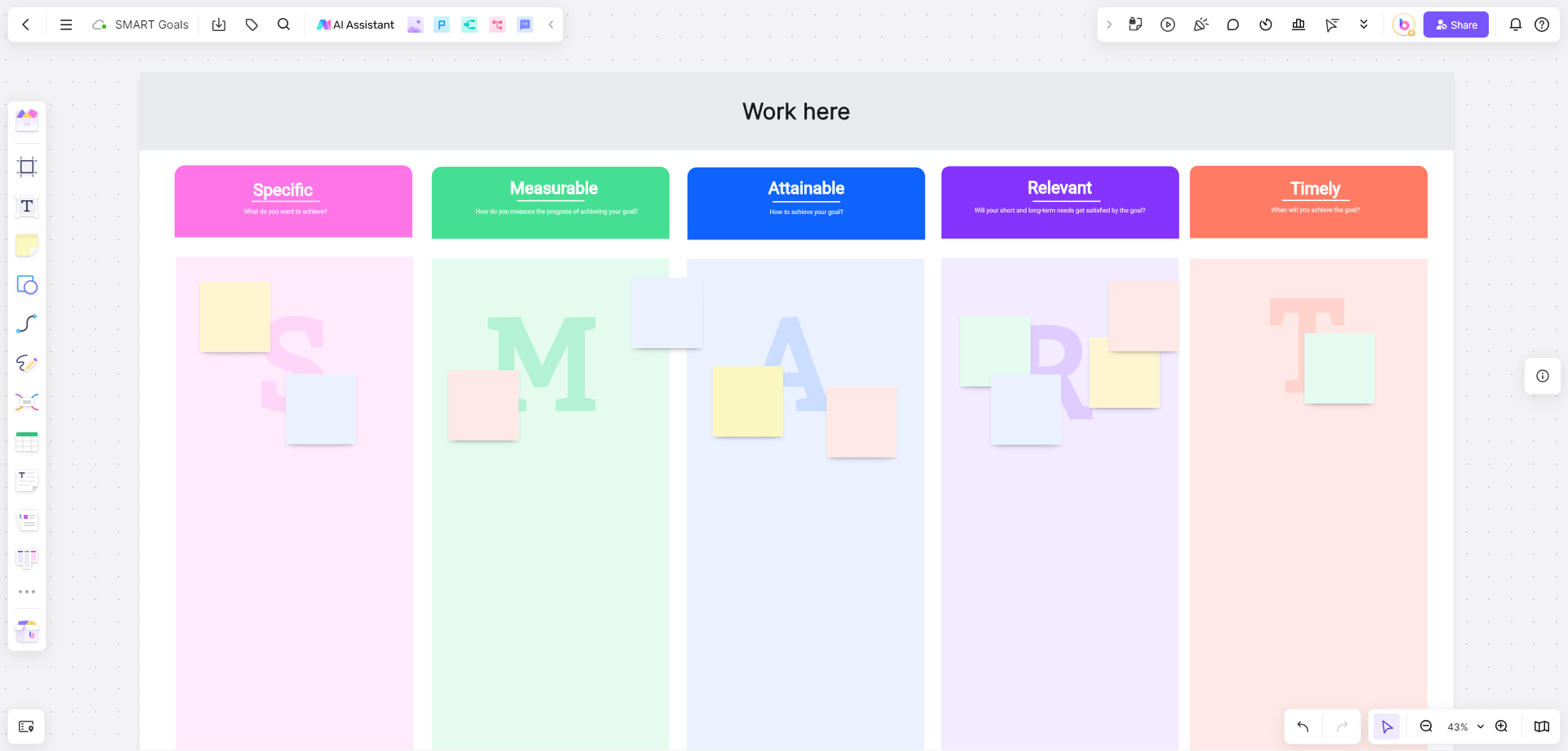
The SMART framework helps set clear and achievable goals. SMART principle example stands for Specific, Measurable, Achievable, Relevant, and Time-bound. Let's break down each principle with examples:
1. Specific
Example: Instead of setting a vague goal like “increase student engagement,” say “increase student engagement in class discussions by implementing interactive teaching techniques.”
2. Measurable
Example: Measurable goals allow you to track progress. For example, “Student engagement increased by 20% next semester” provides a clear metric for measuring success.
3. Achievable
Example: Goals should be realistic. An achievable goal might be to “attend three professional development workshops on interactive teaching methods in the next six months.”
4. Relevant
• Example: Make sure the goals are relevant to your role. A related goal for a teacher might be “Improve my ability to use technology in the classroom to support student learning.”
5. There is a time limit
Example: Time-bound goals have clear deadlines. For example, “Complete classroom technology integration coursework by the end of the school year.”
These principles ensure that goals are clearly defined and achievable within a set time frame, providing a clear path to success.
Professional SMART Development Goals Examples for Teachers
Creating professional SMART goals (Specific, Measurable, Achievable, Relevant, Time-bound) helps teachers set clear, attainable objectives that promote professional growth and improve student outcomes. Here are ten professional SMART goal examples for teachers:
1. Improve Classroom Management Skills
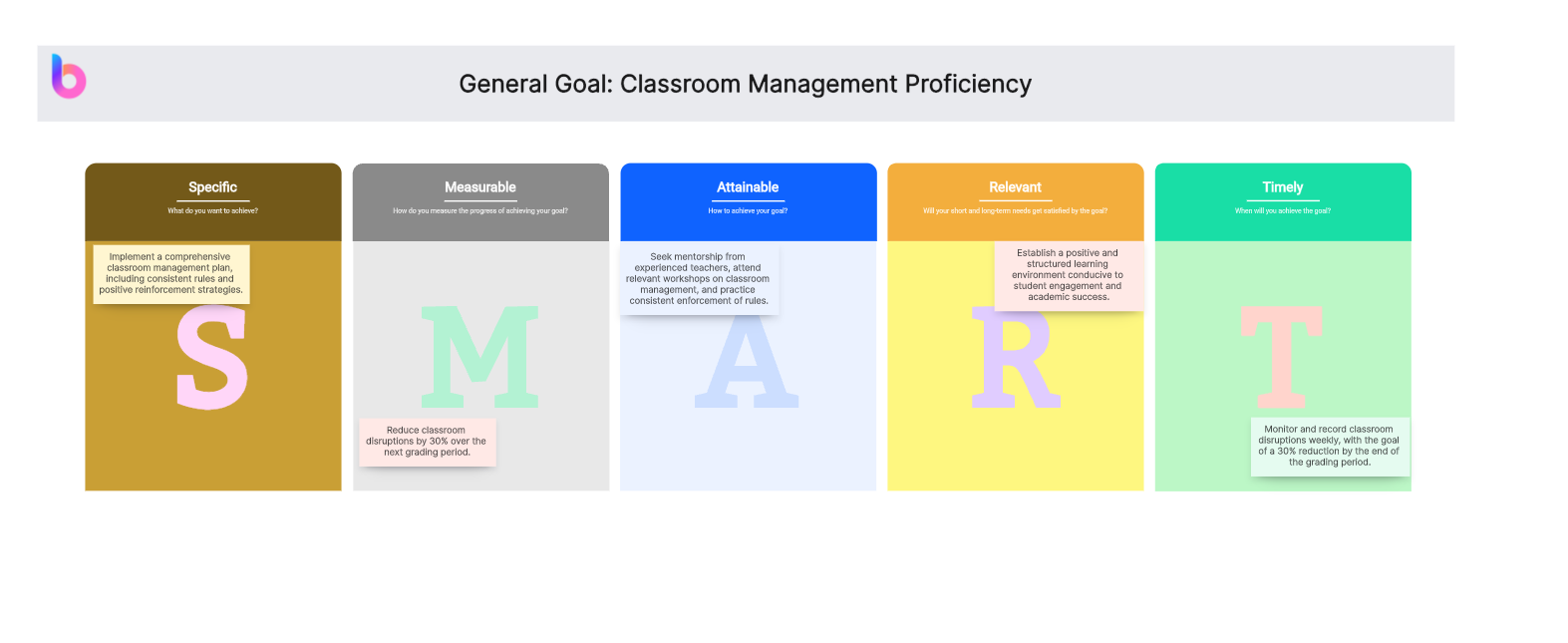
Specific: Implement three new classroom management strategies.
Measurable: Observe a 20% decrease in student disruptions during class.
Achievable: Attend a professional development workshop on classroom management.
Relevant: Effective classroom management leads to better learning outcomes.
Time-bound: Achieve this goal by the end of the current semester.
2. Incorporate Technology in Teaching
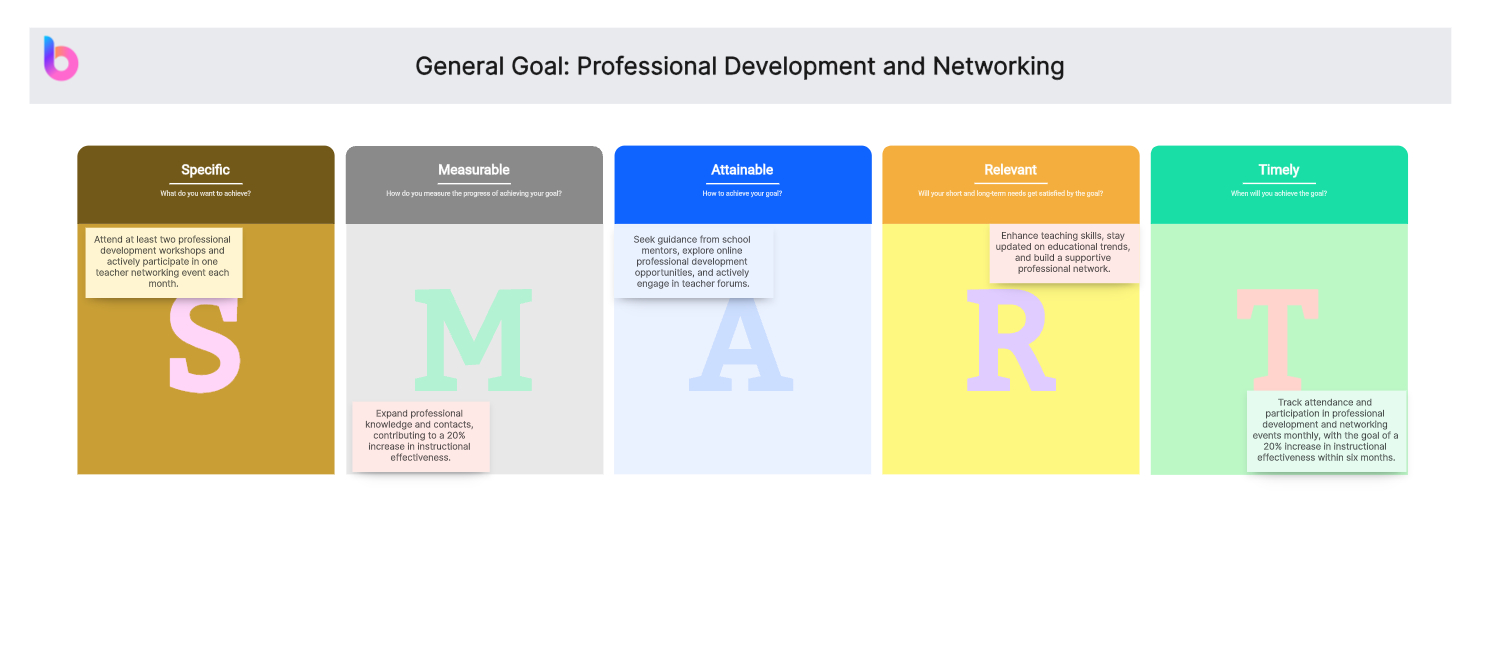
Specific: Integrate two new educational technology tools into lesson plans.
Measurable: Conduct student surveys to measure engagement and understanding.
Achievable: Complete an online course on educational technology tools.
Relevant: Technology can enhance student learning and engagement.
Time-bound: Implement the tools by the end of the school year.
3. Enhance Differentiated Instruction Techniques
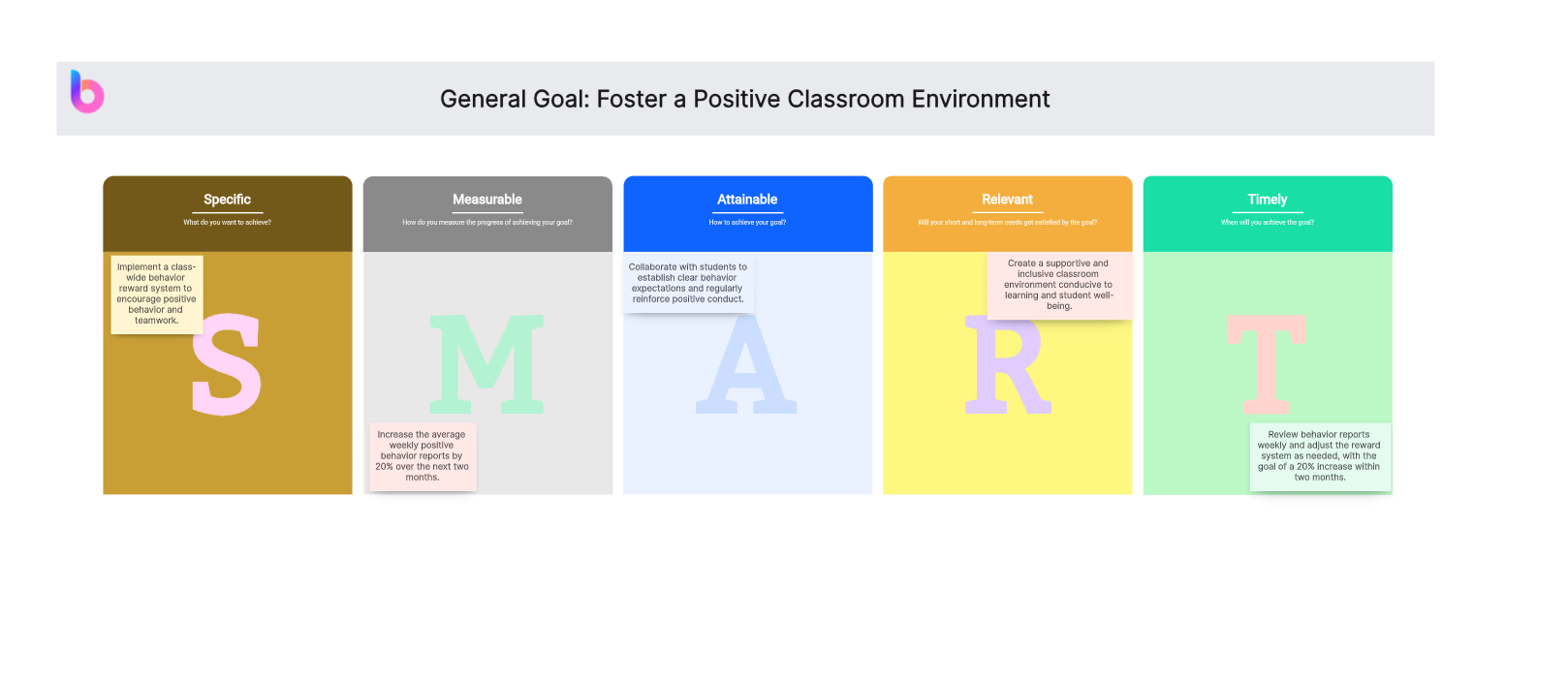
Specific: Develop differentiated lesson plans for at least three units.
Measurable: Track student performance on assessments to measure effectiveness.
Achievable: Collaborate with colleagues to share and develop strategies.
Relevant: Differentiated instruction meets diverse student needs.
Time-bound: Complete by the end of the second semester.
4. Increase Student Reading Levels
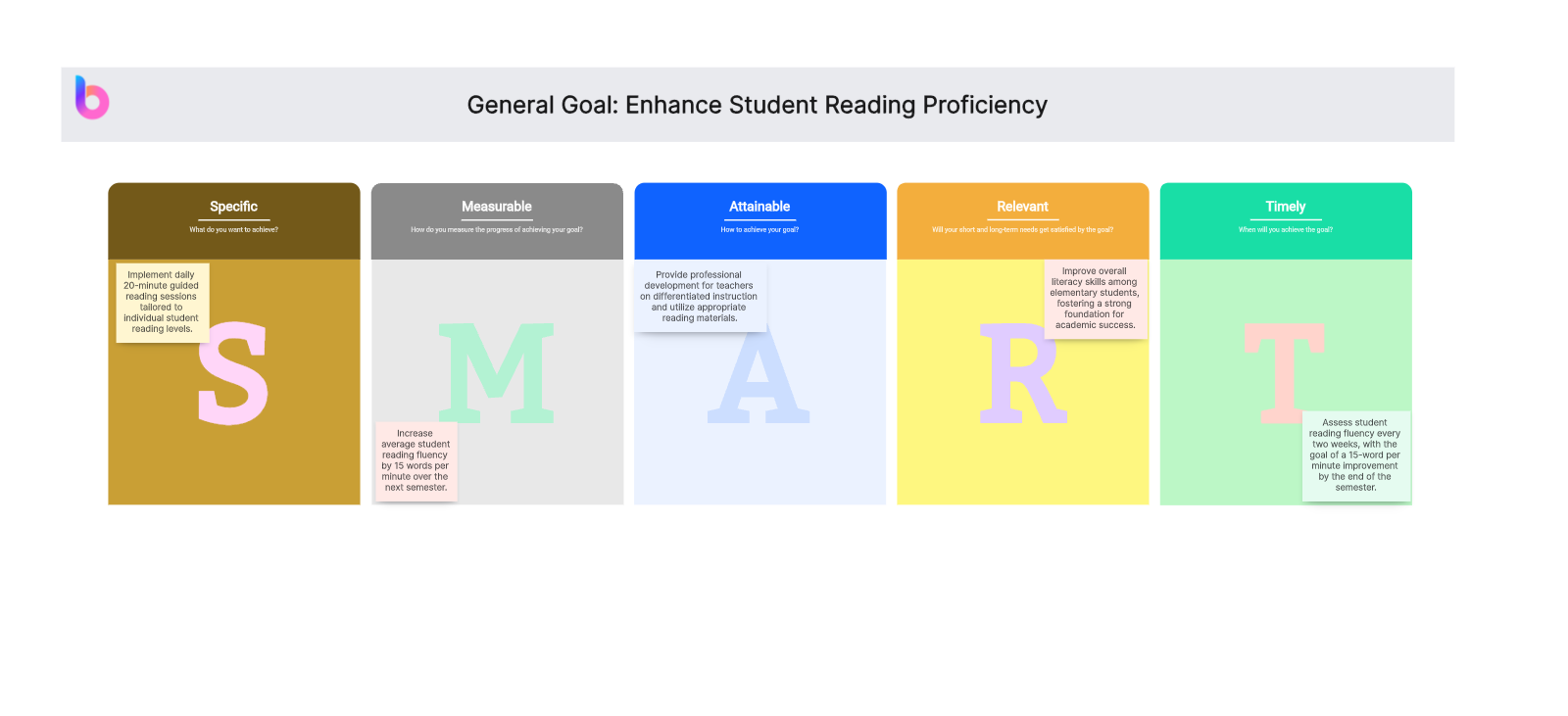
Specific: Implement a guided reading program for struggling readers.
Measurable: Aim for a one-grade level increase in reading scores for participating students.
Achievable: Use existing resources and seek additional training if necessary.
Relevant: Reading proficiency is crucial for academic success.
Time-bound: Achieve this by the end of the school year.
5. Improve Parent-Teacher Communication
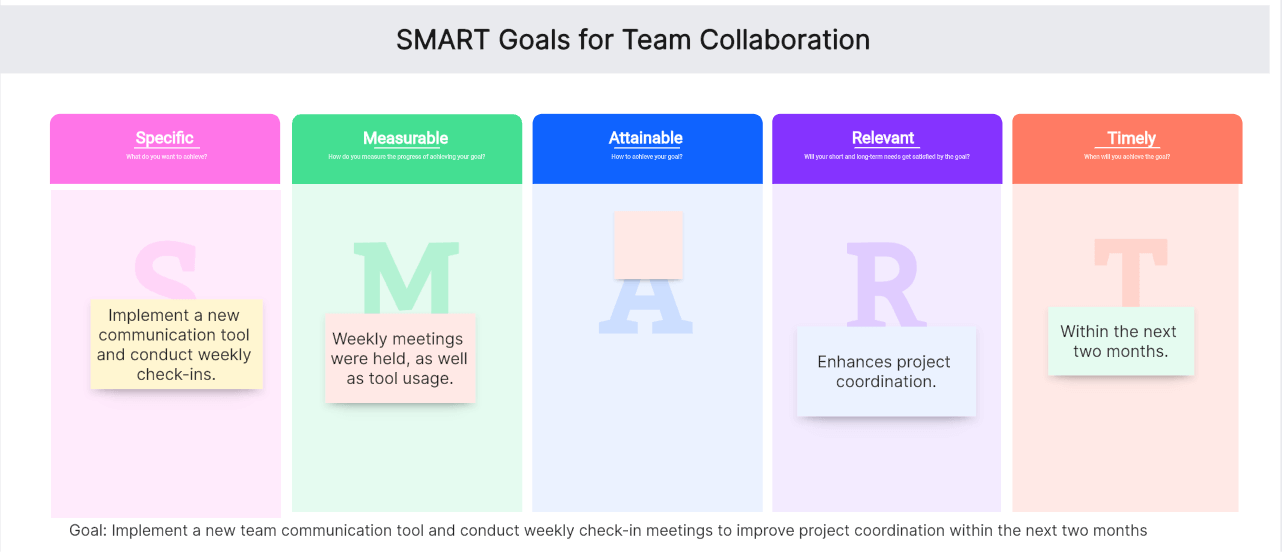
Specific: Establish a monthly newsletter to update parents on classroom activities.
Measurable: Track parent responses and engagement with the newsletter.
Achievable: Allocate time each month for creating and distributing the newsletter.
Relevant: Enhanced communication fosters better parent-teacher relationships.
Time-bound: Start the first newsletter within the first month of school and continue monthly.
6. Develop a Peer Observation Program
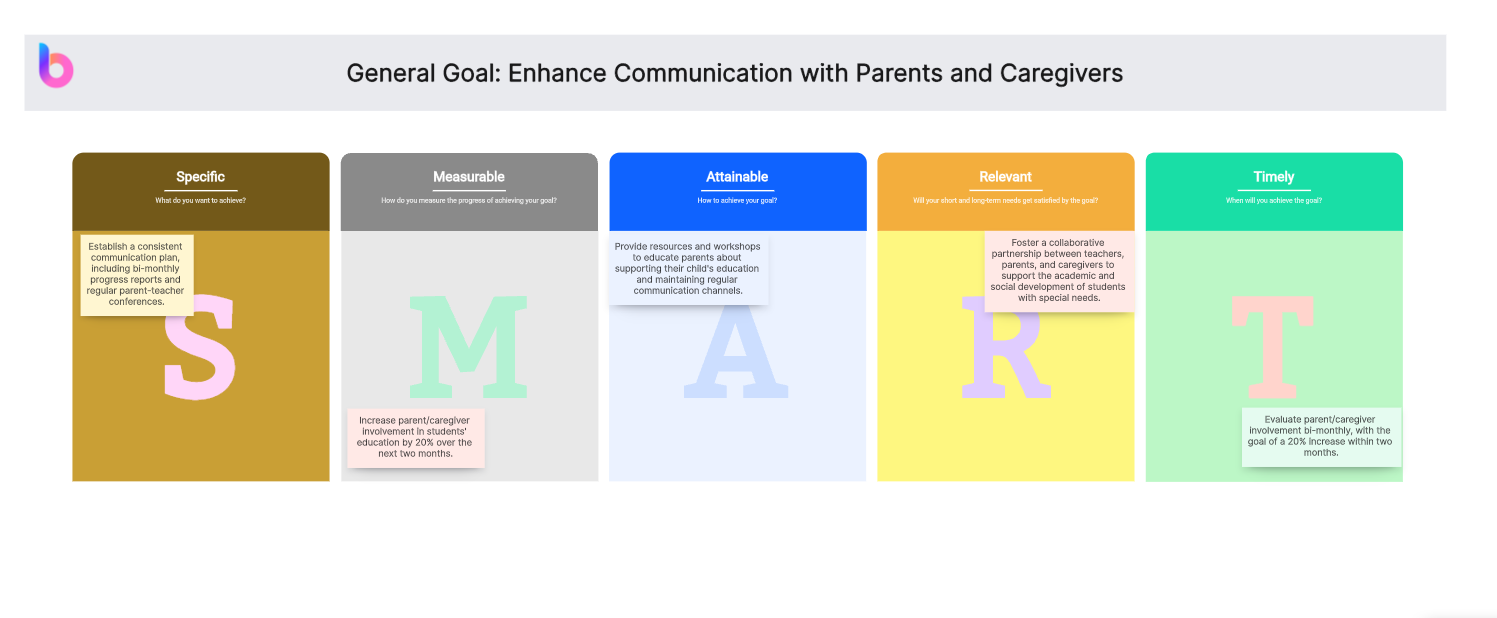
Specific: Conduct peer observations with three colleagues each semester.
Measurable: Provide and receive feedback through observation forms.
Achievable: Schedule time for observations and feedback sessions.
Relevant: Peer observations can provide new teaching insights and strategies.
Time-bound: Begin the program within the first two months of the school year.
7. Increase Student Engagement in STEM
Specific: Incorporate five new hands-on STEM activities into the curriculum.
Measurable: Assess student participation and interest through surveys and participation rates.
Achievable: Research and source materials for activities.
Relevant: Engaging students in STEM can foster critical thinking and problem-solving skills.
Time-bound: Implement these activities by the end of the school year.
8. Enhance Professional Development
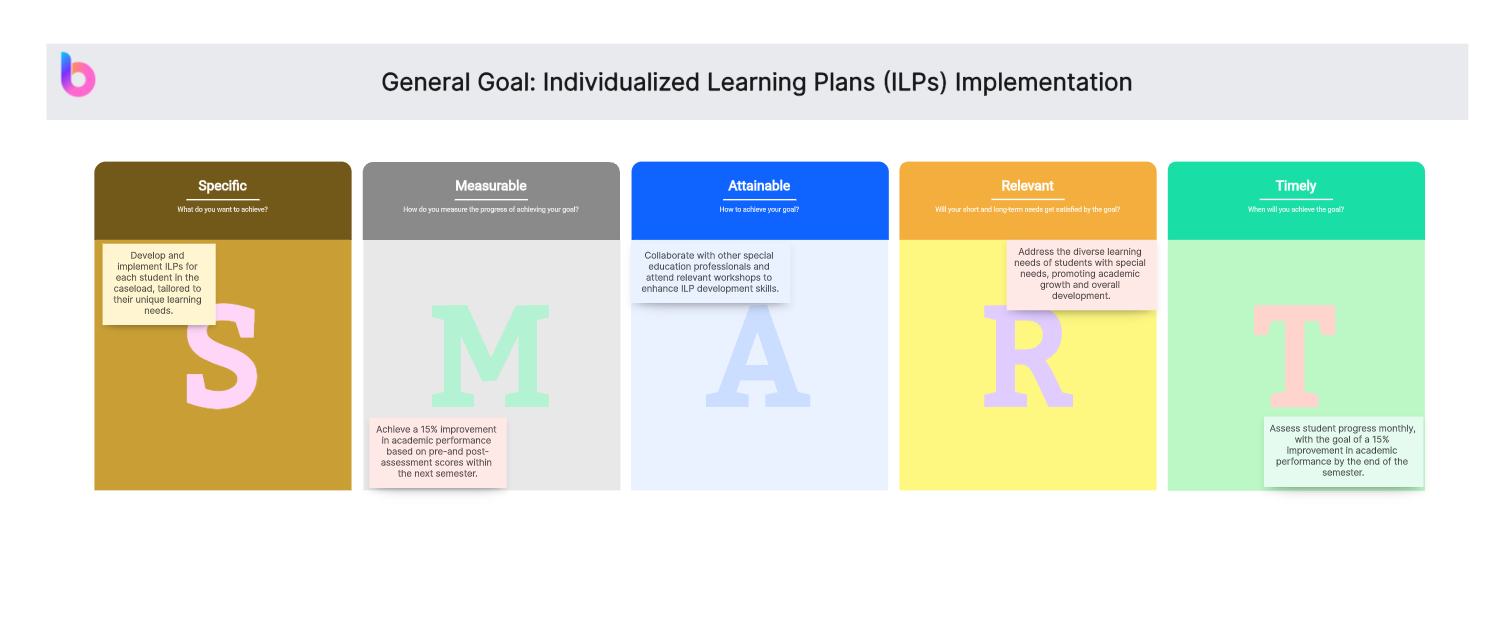
Specific: Attend three professional development workshops related to the subject area.
Measurable: Implement at least one new strategy or idea from each workshop.
Achievable: Identify and register for relevant workshops.
Relevant: Ongoing professional development is essential for staying current in the field.
Time-bound: Complete the workshops by the end of the academic year.
9. Enhance Professional Collaboration
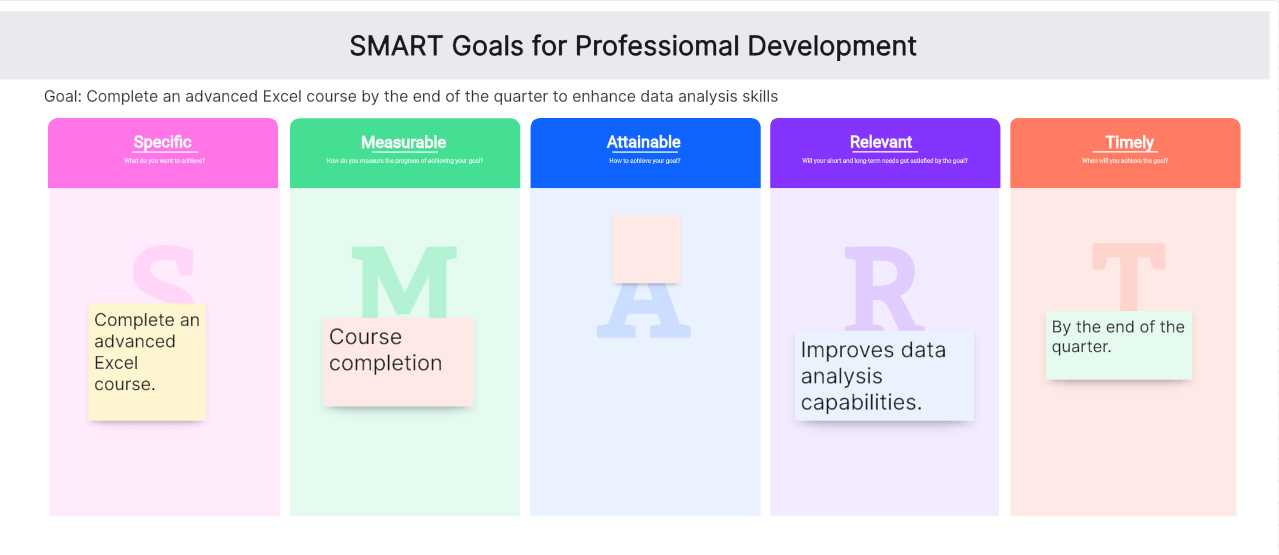
Specific: Participate in collaborative teaching projects with colleagues.
Measurable: Engage in at least two collaborative projects per semester.
Achievable: Schedule regular planning meetings and share resources.
Relevant: Collaboration can lead to improved teaching strategies and student outcomes. Time-bound: Complete these projects by the end of the school year.
10. Increase Use of Data-Driven Instruction
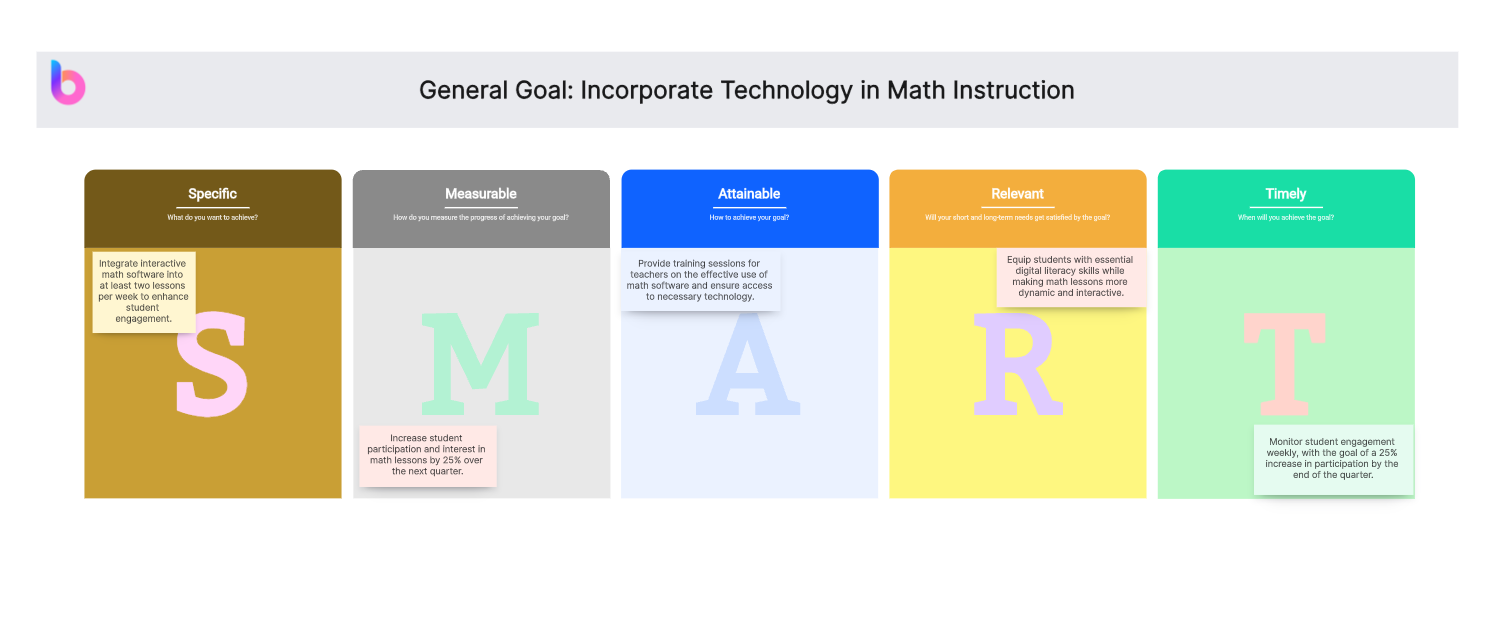
Specific: Use student performance data to inform and adjust teaching strategies.
Measurable: Analyze data from at least three assessments per term.
Achievable: Utilize data analysis tools and attend training on data interpretation.
Relevant: Data-driven instruction can improve student learning outcomes.
Time-bound: Implement data-driven adjustments by the end of each term.
These professional SMART goals examples provide a structured and measurable approach for teachers to enhance their professional skills and improve student learning outcomes.
How Can Teachers Develop Professional SMART Goals?
Developing professional SMART goals example can help teachers focus on specific areas for improvement, set clear expectations, and track their progress. Here’s a step-by-step guide for teachers to develop effective SMART goals:
Step-by-Step Guide to Developing Professional SMART Goals:
1. Reflect on Current Practices and Identify Areas for Improvement
Evaluate Performance: Review student feedback, performance data, and personal reflections.
Identify Needs: Pinpoint areas where improvement is needed, whether in classroom management, student engagement, instructional strategies, or professional knowledge.
2. Set Specific Goals
Clear and Concise: Define the goal clearly and precisely.
Focused: Ensure the goal addresses a specific improvement or professional development area.
3. Make Goals Measurable
Quantifiable: Establish criteria for measuring progress and success.
Trackable: Use tools such as assessments, surveys, or observational checklists to monitor progress.
Example: "Increase student participation in class discussions by 20% over the next semester."
4. Ensure Goals are Achievable
Realistic: Set goals that are challenging but attainable.
Resource Availability: Consider available resources and support, such as professional development opportunities, teaching aids, or peer collaboration.
5. Make Goals Relevant
Align with Professional Growth: Ensure goals are relevant to your teaching responsibilities and career aspirations.
Student Impact: Focus on goals that will positively impact student learning and outcomes.
Example: "Implement new engagement techniques to improve student participation, leading to better learning outcomes."
6. Set Time-Bound Goals
Specific Time Frame: Establish a deadline or time frame to achieve the goal.
Milestones: Break down the goal into smaller, time-bound milestones to track progress.
Example: "Implement the new engagement techniques within the next three months and review their effectiveness by the end of the semester."
Practical Tips for Developing SMART Goals:
Collaborate with Colleagues: Share goals with peers for feedback and support. Collaborative goal setting can provide new perspectives and motivation. You can create the SMART goal example in Boardmix, and share the link to peers, invite them to edit the SMART goal.
Use Data: Base your goals on data from student assessments, feedback, and classroom observations to ensure they are focused on actual needs.
Seek Professional Development: Attend workshops, webinars, and courses that align with your goals to gain new skills and insights.
Regularly Review and Adjust: Periodically review your goals and progress. Adjust strategies and timelines as needed based on what is working or not. Boardmix can save the content timely, and you can adjust the goal anytime and anywhere.
Document Progress: Keep a record of steps taken, resources used, and progress made toward achieving your goals. This documentation can be useful for performance reviews and personal reflection.
Celebrte Achievements: Recognize and celebrate milestones and successes to stay motivated and committed to continuous improvement.
By following these steps and tips, teachers can create effective professional SMART goals example that drive professional growth and enhance student learning outcomes.
How to Overcome Challenges in Setting Professional SMART Goals?
Setting and achieving professional SMART goals can be challenging, but with the right strategies, teachers can overcome these obstacles and reach their objectives. Here are some common challenges and solutions to help navigate them:
1. Lack of Clarity in Goal Setting
Challenge: Goals that are vague or too broad can lead to confusion and lack of direction.
Solution:
Be Specific: Clearly define what you want to achieve. Break down broad goals into smaller, more manageable tasks.
Example: Instead of "improve student engagement," specify "increase student participation in class discussions by 20% within the next semester."
2. Unrealistic Goals
Challenge: Setting goals that are too ambitious or unattainable can lead to frustration and discouragement.
Solution:
Assess Feasibility: Ensure goals are realistic considering your resources, time, and workload.
Incremental Steps: Set smaller, achievable milestones that build towards the larger goal.
Example: If aiming to integrate technology, start with one tool before expanding to others.
3. Lack of Resources or Support
Challenge: Limited access to resources or support can hinder progress.
Solution:
Identify Resources: Determine what resources are needed and where they can be obtained, such as professional development courses, teaching aids, or peer support.
Seek Support: Collaborate with colleagues, seek mentorship, and utilize school resources.
Example: If aiming to improve differentiated instruction, join a professional learning community focused on this area.
4. Time Management Issues
Challenge: Balancing goal-related tasks with daily responsibilities can be difficult.
Solution:
Prioritize Tasks: Use time management techniques like prioritizing tasks, setting deadlines, and creating schedules.
Allocate Time: Dedicate specific times for goal-related activities and stick to the schedule.
Example: Set aside an hour each week to develop and implement new classroom management strategies.
5. Lack of Motivation
Challenge: Losing motivation can stall progress towards achieving goals.
Solution:
Set Short-Term Milestones: Break down goals into smaller, short-term objectives to create a sense of accomplishment.
Celebrate Successes: Recognize and celebrate achievements, no matter how small, to maintain motivation.
Example: Reward yourself after completing each milestone in a long-term goal.
6. Resistance to Change
Challenge: Resistance to new methods or changes in routine can impede goal achievement.
Solution:
Gradual Implementation: Introduce changes gradually to allow adjustment.
Stay Open-Minded: Be open to new ideas and approaches. Reflect on the benefits of change.
Example: If introducing a new teaching technology, start with one class or lesson to test its effectiveness before wider implementation.
7. Monitoring and Adjusting Goals
Challenge: Failing to track progress and adjust goals can lead to stagnation.
Solution:
Regular Reviews: Schedule regular reviews to assess progress and make necessary adjustments.
Be Flexible: Be willing to modify goals based on feedback and changing circumstances.
Example: If a strategy isn’t working, analyze why and adjust the approach or set a more achievable target.
8. Balancing Multiple Goals
Challenge: Managing multiple goals simultaneously can be overwhelming.
Solution:
Prioritize Goals: Determine which goals are most important and focus on them first.
Stagger Deadlines: Set different deadlines for each goal to avoid overlap and reduce pressure.
Example: Focus on improving classroom management in the first semester and integrating new technology in the second semester.
Practical Tips to Overcome Challenges:
Utilize Goal-Setting Tools: Use tools like planners, apps, and software to set, track, and manage goals effectively.
Seek Professional Development: Continuously seek opportunities for professional growth to gain new skills and strategies.
Engage in Reflection: Regularly reflect on what is working and what isn’t, and be willing to adapt.
Build a Support Network: Surround yourself with supportive colleagues, mentors, and administrators.
Maintain a Positive Mindset: Stay positive and persistent, and remind yourself of the long-term benefits of achieving your goals.
By recognizing and addressing these challenges proactively, teachers can set and achieve their professional SMART goals more effectively, leading to enhanced teaching practices and improved student outcomes.
Setting and achieving professional SMART goals is essential for teachers' continuous improvement and career advancement. By understanding and applying the SMART principles, teachers can create clear, measurable, and achievable objectives that align with their professional development needs. Through careful planning, dedicated effort, and overcoming challenges, teachers can enhance their teaching practices, ultimately benefiting their students and themselves.









